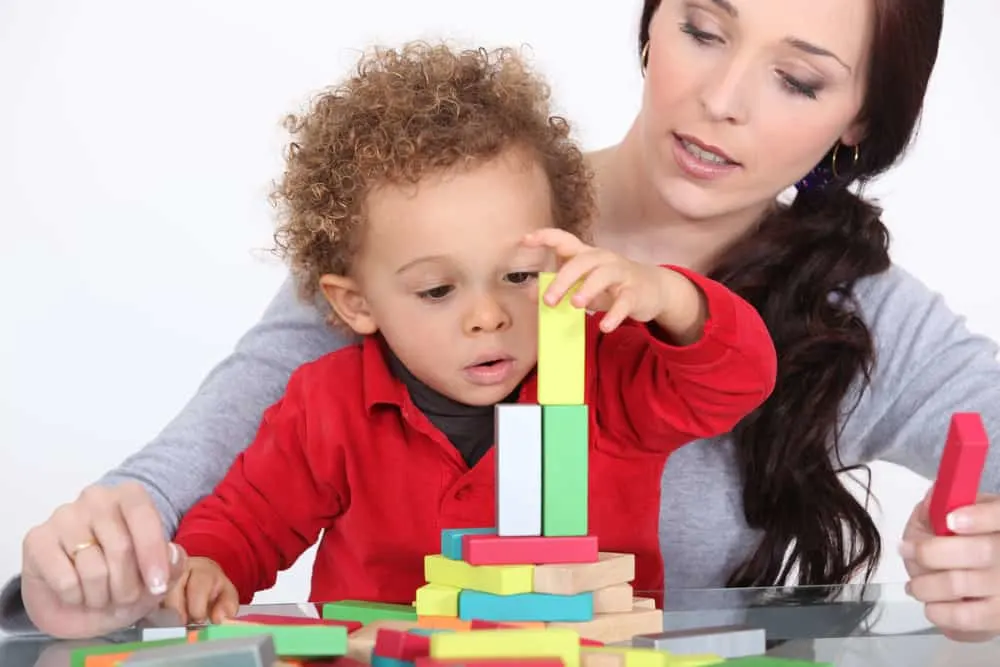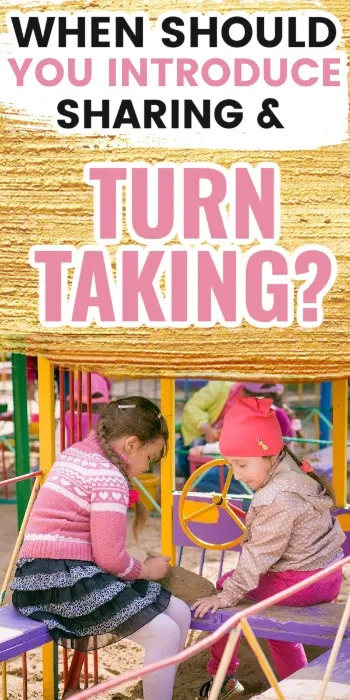How can you teach your toddler to share?
This is a question I get from a lot of parents as a developmental therapist that specializes in babies and toddlers.
The most important thing you need to keep in mind is that although we can introduce the concept of sharing and turn-taking to toddlers, it should not be an expectation!
Let me explain, toddlers’ brains are still developing and they may not be able to fully understand the concept of sharing until they are a bit older.
All kids are different but usually we start to see children start to understand sharing at around 4 years old.
It can be hard for them to share until they’re a little older, so it’s important not to force the issue or make your toddler feel guilty about not sharing.
Instead, use activities that will introduce the concept without making them feel pressured or having it be an expectation.

(This post may contain affiliate links. To read our full disclosure policy click here.)
When is the best time to introduce sharing and turn-taking?
You can introduce turn-taking and sharing activities at any age, as long as you don’t expect it.
If you are using fun and low-pressure ways you can start at a very early age.
Model Sharing for Young Children
One of the most important activities you can do to help teach your toddler how to share is to model it.
Your little one is watching you all throughout the day and they will pick up on what you are doing!
This is an easy thing to do during daily routines.
For example, if you just made yourself a snack offer someone else part of it.
“I just got some crackers and cheese, I can share mine with you if you are hungry.”
You can do the same thing with turn-taking when different opportunities come up throughout the day.
Cooking with your child can be a great activity to practice taking turns.
While you’re mixing the batter for muffins, stop and see if your toddler would like a turn.
Read Books to Teach Turn Taking
Books can be a great way to teach young children about sharing and turn-taking.
When reading a book with a child, you can pause at key points to talk about how the characters are sharing or taking turns.
This can help to reinforce the importance of these concepts for your child.
You can also use books as a springboard for discussion and activities related to sharing and turn-taking.
For example, you might read a book about two friends sharing a toy, and then have your child act out the story with two of their own toys.
As they play, you can encourage them to take turns with the toys.
By using books and playtime together, you can help your child learn important skills for sharing and turn-taking.
Here are some of my favorite books that support social-emotional development in young children.
Use Puppet Play to Introduce Social Skills
Puppets are a wonderful way to teach young children about sharing and other social-emotional skills.
When children see puppets sharing, they learn that sharing is an important part of life.
Puppets (like these) can also help children to understand and express their emotions. For example, if a child is feeling angry, they can see a puppet get angry in a healthy way.
This can help the child to understand and manage their own anger.
Overall, puppets are a fun and valuable tool for teaching young children about sharing and other social-emotional skills.

Building Activities are Great for Taking Turns
There are a few ways to teach sharing and turn-taking through block play.
When you are playing with blocks with a child, show them how to take turns.
For example, you can build a few towers and then let the child knock them down.
Take turns doing this so that your little one sees that it is something that you do together.
You can also help the child to understand sharing by dividing the blocks into two piles.
One pile is for you and one pile is for them.
This way, the child knows that they need to share the blocks with you. If they want more blocks, they need to give some of their blocks to you first.
I was playing with blocks with my four-year-old the other day and another thing that we did was take turns to build a tower.
She would put a block and then I would add one. We went back and forth and built the tower together.
It was a fun way to show how turn-taking can make an activity more fun!
Playing Games is a Fantastic Way to Support Social Skills
Games are a great way to teach sharing and turn-taking.
When you’re playing a game, everyone has to wait their turn and share the resources.
This is a good way to teach kids how to be patient and take turns.
It’s also a good way to teach sharing because everyone has to share the same resources.
Games are a fun way to learn about sharing and turn-taking, and they’re also a good way to bond with family and friends.
You can see some of my favorite games for young children HERE.
Read or Tell a Social Story about Sharing
One way to teach a child about sharing is to use a social story.
A social story is a short, simple story that describes a situation and includes the child’s perspective.
When sharing is introduced in a social story, it normalizes the concept and helps the child to understand why sharing is important.
For example, a social story about sharing could describe a situation in which two children are playing with a toy.
One child wants to play with the toy by himself, but the other child wants to share.
The story would then explain how sharing can help both children to enjoy the toy.
By using a social story, you can help your child to understand the concept of sharing in a simple and relatable way.
Watch Shows or Videos that Teach Sharing
Is your child a fan of Daniel Tiger or Bluey?
These are two of my favorite kid shows because they have some really good episodes that explore social-emotional skills like the ones we are talking about in this post.
Watching a show together can be a fun way for children to start seeing the idea of sharing with other children and what it may look like.
They can see how the characters feel about it and how they navigate it in different ways.

Be Patient When it Comes to Sharing
Even though it is not developmentally appropriate to expect toddlers to share, you can still introduce sharing and turn-taking in a fun and low-pressure way.
By following these tips, you will be able to help your toddler understand the concept of sharing without putting too much pressure on them.
For more tips like this, follow along on Tik Tok!
Frequently Asked Questions
Sharing can be a difficult concept for young children to understand.
The activities and ideas in this post are a great way to start teaching your child about sharing, turn-taking, and other social-emotional skills.
Additionally, you can model sharing behavior with your own friends and family members, read books or tell stories about sharing.
Most two-year-olds will not yet understand the concept of sharing and it should not be an expectation.
However, activities such as the ones outlined in this post can help to introduce the concept of sharing and turn-taking.
It is important that you provide a safe environment for them to practice these skills.
It is completely normal for toddlers not to share, as it can be a difficult concept for them to understand.
By modeling sharing behavior, providing activities that encourage taking turns, and introducing social stories about sharing, you can help your toddler develop the skills they need in order to understand and practice sharing with others.
Related Posts You Will Enjoy
Best Outdoor Toys for 2 Year Olds
How to Promote Language Development in Toddlers
Signs Your Child is Not Ready for Potty Training
How to Deal with Toddler Temper Tantrums in Public
The Best Insect Activities for Toddlers

Grab your FREE Milestone Guide HERE.


Kayla O’Neill has a master’s degree in education as well as a bachelor’s degree in special education with an emphasis in early childhood education. She has been working as a developmental therapist with babies and toddlers in early intervention since 2012. She is also a mom with two young children.